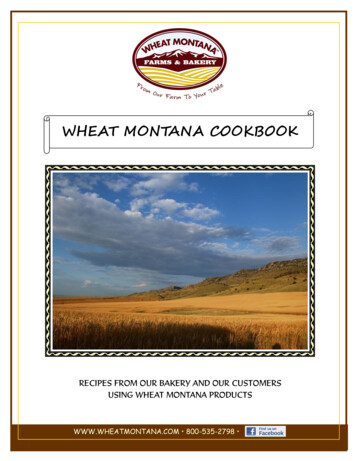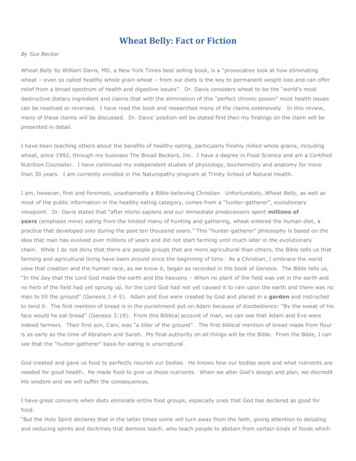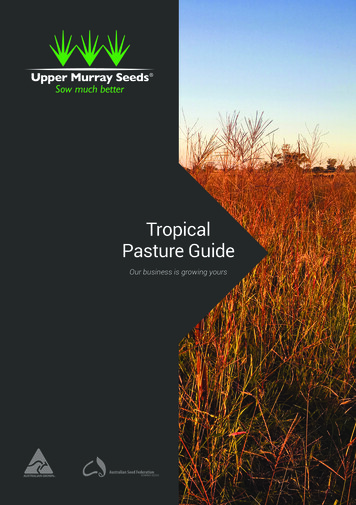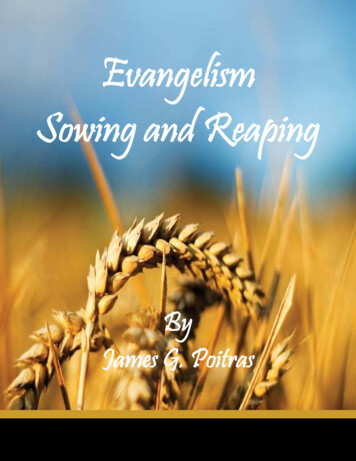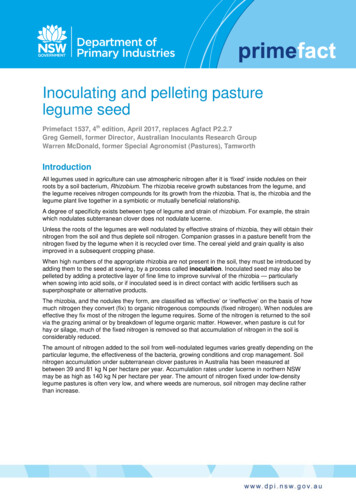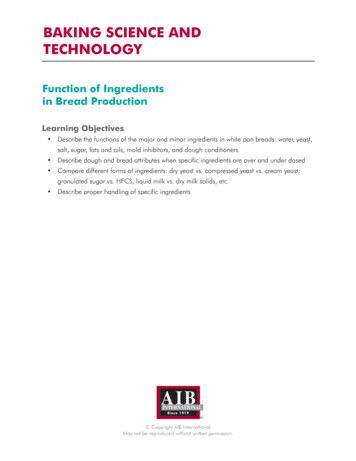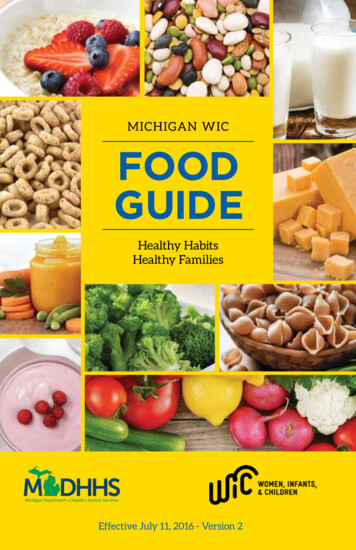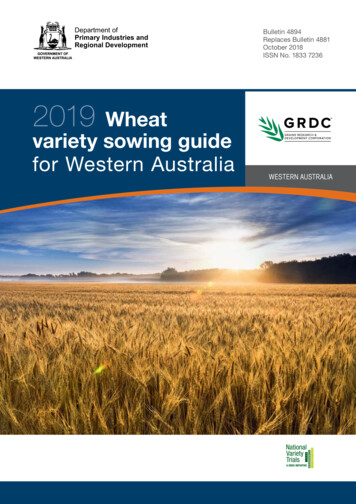
Transcription
Department ofPrimary Industries andRegional DevelopmentBulletin 4894Replaces Bulletin 4881October 2018ISSN No. 1833 72362019Wheatvariety sowing guidefor Western AustraliaWESTERN AUSTRALIAnvtonline.com.au agric.wa.gov.au1
Important disclaimerAcknowledgmentsThe Chief Executive Officer of the Departmentof Primary Industries and Regional Developmentand the State of Western Australia accept noliability whatsoever by reason of negligence orotherwise arising from the use or release of thisinformation or any part of it.This publication presents data and informationdeveloped from research supported by theDepartment of Primary Industries and RegionalDevelopment (DPIRD) and the Grains Researchand Development Corporation (GRDC). Yieldinformation for varieties is provided throughthe GRDC’s National Variety Trials (NVT)project. We acknowledge NVT trial operatorsand grain breeding organisations for varietalyield comparison information. The informationcontained in this Bulletin is based on the workconducted by many research scientists, technicalofficers and plant breeders. The authors wouldlike to thank the following groups of people fromDPIRD:Copyright Western Australia AgricultureAuthority 2018.Tel: 61 (0)8 9368 3333Email: enquiries@dpird.wa.gov.auWebsite: agric.wa.gov.auAbbreviations used are: CCN Cereal cyst nematodeRLN Root lesion nematodePM Powdery mildewYLS Yellow leaf spotFNI Falling Number IndexAH Australian Hard (min. protein 11.5%)APW Australian Premium White (min.protein 10%)APWN Australian Premium White NoodleANW Australian Standard Noodle (protein9.5–11.5%)FEED Australian FeedEPR End Point Royalty 2017-18 quoted /tonne ex-GSTCL Clearfield Wheat agronomy: Bob French, Bruce Haig,Melanie Kupsch, Rod Bowey, ShahajahanMiyan, Helen Cooper.Biometrics: Mario D’Antuono.Frost: Kelly Ryan.Plant pathology: Donna Foster, RyanVarischetti, Hossein Golzar, DortheJorgensen, Jason Bradley and Sarah Collins.Entomology: Dusty Severtson and SvetlanaMicic.Research support units: Carnarvon,Esperance, Geraldton, Katanning, Manjimup,Merredin, Northam, Shenton Park (UWA) andWongan Hills.Chris Carter and Ross Kingwell providedinformation on price by class which is very muchappreciated.We highly value the contributions of ColinEdmondson, Kynan Jackson, Josh Johnson, BillMoore, Ian Edwards and Dan Mullan for providinginformation to assist with the production of thebulletin.2nvtonline.com.au agric.wa.gov.au
Bulletin 4894Replaces Bulletin 4881October 2018ISSN: 1833 72362019Wheatvariety sowing guidefor Western AustraliaEdited byGeorgia Trainor, Christine Zaicou-Kunesch, Jeremy Curry,Brenda Shackley and Dion NicolDepartment of Primary Industries and Regional Development.ContentsIntroduction4.What to look out for now – new releases4.Variety classification5.What should I grow and when?5.Disease update16.Variety management – Agronomy21Wheat for early sowing27Herbicide tolerance30Factsheets33.Price difference by class44Classification47.Essentials for a successful wheat crop48.Seed distributer and marketer information50.nvtonline.com.au agric.wa.gov.au3
IntroductionGeorgia TrainorThe 2019 Wheat variety sowing guide forWestern Australia provides information to supportgrowers with decisions on variety selectionand management. This publication contains asummary on the yield performance of varietiesin the NVT, disease resistance ratings, a newsection on winter wheat varieties and agronomicinformation. Quick reference fact sheets for 22commonly grown and recently released varietiesare also available at the back of the guide,along with grain marketing information and seeddistributor information.When deciding whether to implement a newvariety into your farming system, it is importantto determine whether the change will provide anadvantage. A new variety should: have better or equal yield, grain quality and/or disease traitsprovide diversity or risk mitigationsuit current market requirements.Reviewing available trial information (NVT orDPIRD trials) is recommended. This bulletinprovides available information on disease,agronomy, yield and quality characteristics toassist you with variety choice and management.What to look out for now – newreleasesGeorgia TrainorThere have been a number of newly released linesin 2018.Devil is a short-mid season, Australian Hard(AH) wheat variety from InterGrain. Devil wasincluded in the national variety trials for the firsttime in 2017. Its yields in 2017 were very similarto Scepter (within 1-3 percent) across all Agzones(Tables 2 to 10). Devil is moderately resistant tostripe rust, moderately resistant to moderatelysusceptible to the older leaf rust pathotype butsusceptible to very susceptible to the latest leafrust pathotype.Illabo is a dual purpose winter wheat for grazingand grain production from AGT. Its maturity is3 days quicker than EGA Wedgetail. Until thisvariety’s quality is classified for WA it will bedelivered as a feed wheat. lllabo is moderatelyresistant to stripe rust, moderately resistant topowdery mildew and resistant to flag smut.Kinsei is a mid-long season variety, released byIntergrain, with the classification of AustralianStandard Noodle (ANW). InterGrain recommendKinsei to noodle growers in the southern areasof the state who are looking for a variety that islonger to mature than Zen and for growers lookingfor a variety of different maturity to spread frostrisk. Kinsei was included in the NVT for the firsttime in 2017, where it yielded slightly less thanNinja (except in Agzone 1), but out-yielded bothZen and Calingiri.Razor CL Plus is an Australian Standard White(ASW) Clearfield variety released by AGT in early2018. This variety provides an imidazolinoneweed control option for growers in problempaddocks that generally produce low proteincrops. Information from the breeder suggests thatRazor CL Plus yields higher than Grenade CL Plus(another AGT Clearfield variety with APW grading).In its first year in the NVT, Razor CL Plus had asimilar yield to Mace and Chief CL Plus.Another two varieties released in 2018 byInterGrain are Sheriff CL Plus and Vixen. Atthe time of publication, Sheriff CL Plus is a feedvariety in WA and seed is not available for the2019 season. Vixen, a high yielding AH variety willbe available to WA growers for the 2020 season ifseed becomes available.For more information on these varieties, contactthe breeder (contact details at the end of thisdocument).4nvtonline.com.au agric.wa.gov.au
Variety classificationSource: Wheat Quality Australia (WQA).The following class changes will apply in 2018: Carnamah: AH to APWHalberd: APW to ASWSpear: APW to ASWTo allow varietal control for maintaining productquality for the premium Japanese Udon noodlemarket, the classification of APWN is now a newsegregation in 2018 for the following AH andAPW varieties: Chief CL Plus, Devil, EGA BonnieRock, Envoy, King Rock, LRPB Scout, Mace,Westonia and Wyalkatchem.What should I grow and when?Dion Nicol and Georgia TrainorSince its release in 2008, Mace has becomedominant in wheat plantings across Australia.The adoption of this variety was at theexpense of older competing varieties such asWyalkatchem, Westonia and Carnamah thatwere replaced due to Mace’s better yields, AHclassification, stronger disease and sproutingtolerance. 2015 saw the introduction of Scepterwhich has similar agronomic characteristics toMace but has an average yield advantage ofaround 8 and 10 per cent. This increase in yieldis far greater than the yield advantage Mace hadover its key rival Wyalkatchem. In the comingyears, Scepter looks set to replace Mace asthe dominant variety and is already the secondmost planted wheat variety in Western Australia(Figure 1).With the superior yield performance of Scepterover three years of NVT, what else shouldbe grown and why? Diversifying into anothervariety should provide a measurable change inrisk or opportunity. It is important to consideryield performance in your environment and ifits maturity matches the targeted sowing time,the variety’s grain quality classification and itsvalue, disease risk profile and sprouting risk (FNI).Another essential annual activity is to reviewvariety’s disease ratings as these may havechanged due to new pathogens.To assist with the comparison of varieties,Tables 1-4 provide a snapshot of yields, diseaseratings, falling number index and relativematurity of varieties across yield groups, qualityclassifications and maturity. Notable varietiesare compared with Scepter and Mace toassist in variety selection. Preferred agronomiccharacteristics and disease traits will vary inpriority based on the pressure in the targetenvironment.Area sown 20162017YearFigure 1 Estimated area sown (% state plantings) of wheat varieties in Western Australia between 2012 and 2017.Source: CBH Groupnvtonline.com.au agric.wa.gov.au5
AH and APW short-mid season varietiesWhile a number of varieties released in the lastfive years can out-yield Mace, they are generallyinferior to Scepter in agronomic package and/or yield (Table 1). The yield advantage of Scepterhas been consistent in many environments anda wide range of yield potentials (Figure 2a). Thenewly released variety Devil is an AH short-midmaturity wheat released by InterGrain. While thereis only one year of data currently available on thisvariety, yield performance in the 2017 NVT wassimilar to Scepter.CL Plus wheatsWheat varieties denoted with ‘CL Plus’ identifiesthem as varieties with two resistance genes forImidazolinone herbicides and are registeredfor spraying with label rates of Intervix . Priorto the release of Chief CL Plus, Clearfield wheat varieties were significantly behind theelite varieties in yield. Chief CL Plus (APW) hascontinued to perform well, remaining competitivewith Mace in the NVT and far out-yields previousCL Plus varieties (Figure 2b). Chief CL Plus alsohas a good overall agronomic package withgood disease ratings (except for stripe rust)and a sound falling number index. Two newreleases, Razor CL Plus and Sheriff CL Plus, haveperformed similarly to Chief CL Plus in NVT yielddata to date. However, Razor CL Plus is ASWand Sheriff CL Plus will be delivered as a feedvariety until further quality information becomesavailable.Mid-long season varietiesMid-long maturity wheats are important for earlysowing or providing frost risk management.This is evident by the stability of the area sownto longer season varieties over the past fiveyears (Figure 1). Although most NVT are sownin May, which suits short-mid and mid maturingwheats, a number of mid-long maturities are stillcompetitive. For example, Cutlass, Magenta,LRPB Trojan are on average yielding similarlyto Mace. The differences in traits of the variousTable 1 Summary of wheat variety traits comparing Scepter with four top yielding AH and APW short-mid season wheat varieties.(Source: NVT Online)VarietyGradeYield (% Scepter)Yield (% Mace)MaturityFalling no. indexStem RustStripe RustLeaf rust (old Lr76 pathotype)Leaf rust (new Lr104 pathotype)Powdery mildewYellow evilAH98% 106% Short-mid–MSSpMRpMRMS#SVSp–MRMSpLRPB MRMSRMR*MSSMS#MSSMRMS - Single year data only. For other symbol definitions see the disease rating tableTable 2 Summary of wheat variety traits comparing Scepter with CL Plus wheat varieties. (Source: NVT Online)VarietyGradeYield (% Scepter)Yield (% Mace)MaturityFalling no. indexStem RustStripe RustLeaf rust (old Lr76 pathotype)Leaf rust (new Lr104 pathotype)Powdery mildewYellow azor CL PlusASW93% 100% Short–MRMSRMRRMR#SSpMSChief CL PlusAPW91%99%Mid4MRSRR*MSSpMRMSGrenade CL PlusAPW82%89%Short-mid5MRRMRMS#SMSSSImpress CL PlusAPW78%85%Short-mid2MRMSSRR*SVSMRMS - Single year data only. For other symbol definitions see the disease rating table6nvtonline.com.au agric.wa.gov.au
Table 3 Summary of wheat variety traits comparing Scepter with five top yielding AH and APW mid-long season wheatvarieties. (Source: NVT Online)VarietyGradeYield (% Scepter)Yield (% Mace)MaturityFalling no. indexStem RustStripe RustLeaf rust (old Lr76 pathotype)Leaf rust (new Lr104 pathotype)Powdery mildewYellow inseiANW94% 101% SR*RMR*MRMS(MR)LRPB 4%Mid-long5SMRMSMSSSMRMSSVS - Single year data only. For other symbol definitions see the disease rating tableTable 4 Summary of wheat variety traits comparing Scepter with noodle wheat varieties. (Source: NVT Online)VarietyGradeYield (% Scepter)Yield (% Mace)MaturityFalling no. indexStem RustStripe RustLeaf rust (old Lr76 pathotype)Leaf rust (new Lr104 pathotype)Powdery mildewYellow injaANW98%106%Mid4SVSMSMS#SSVSMRMSKinseiANW94% 101% #SSMSS - Single year of NVT data only. For other symbol definitions see the disease rating tablevarieties suggest regional preferences shouldbe expected. For example, the foliar diseaseresistance package of Magenta is strong,particularly for yellow leaf spot and powderymildew, but its falling number index rating is 3which deems it risky to grow where sproutingmay be a higher risk. Cutlass is superior toYitpi in yield and quite yield stable for a longermaturing wheat (best of longer maturities in below4 tonne group yield sites) (Figure 2c). Cutlass isvery strong for rust resistance but susceptible topowdery mildew and MSS for yellow leaf spotwhich although is an improvement over Yitpi, itis not suited to high disease pressure (SVS toyellow spot). LRPB Trojan has a FNI of 5 whichis slight better than Cutlass so may be suitedwhere sprouting is a concern and yield potentialis very high. The recently release, Kinsei, hasperformed very well in 2017 NVT, although moreseasons are needed to determine its yield stabilityand its susceptibility to powdery mildew is notyet known. Refer to Tables 19 and 20 for yieldperformance with early sowing. DS Pascal alsopresents a longer maturing option with leadingpowdery mildew and pre-harvest sproutingtolerance, although it has had limited NVT testingfor yield comparisons.ANWNinja has been the second highest yieldingmilling wheat after Scepter in the NVT between2015-17 (Table 4). It has improved yields overall other ANW varieties (Figure 2d). Ninja has amarginally shorter maturity than Zen and Calingiri.Ninja is highly susceptible to powdery mildewand stem rust and should be actively monitoredand managed. Zen’s disease ratings are onlymarginally better and it has a lower falling numberindex and is inferior in yield to Ninja. The newlyreleased, longer maturing ANW, Kinsei, hasperformed very well for yield in the single year ofNVT data and is longer maturing than Calingiriand Zen.nvtonline.com.au agric.wa.gov.au7
Yield difference (t/ha)0.62aScepter0.4LRPB Havoc0.2Devil 0Hydra-0.2Mace-0.4-0.61234Group yield (t/ha)56Yield difference (t/ha)0.62bScepter0.4Razor CL Plus 0.2Chief CL Plus0Justica CL Plus-0.2Grenade CL Plus-0.4-0.61234Group yield (t/ha)56Yield difference (t/ha)0.6ScepterKinsei LRPB 4Group yield (t/ha)56Yield difference (t/ha)0.62dScepter0.4Ninja0.2Kinsei 0Zen-0.2Calingiri-0.4-0.61234Group yield (t/ha)56Figure 2a–d Variation from site mean yield of selected varieties against group yield of NVT sites in comparison to Scepter.a Short-mid maturity AH and APW varieties, b. Clearfield (CL Plus) varieties, c. Mid-long maturity varieties and d. ANWvarieties indicates one year of data only. Source: Long term yield reporter nvtonline.com.au8nvtonline.com.au agric.wa.gov.au
Variety performance in Agzones and suggested planting timesChristine Zaicou-KuneschThe data resulting from NVT trials can be usedto assess the relative performance of one varietyagainst another each season. However, there isvalue in assessing a variety’s yield in the NVTover a number of years to provide insight into thestability of its performance across a number ofseasons. Many of the recently released varietieshave been in NVT since 2015 and there aresome varieties which have performed similarlyor better than Mace over a number of seasons(Tables 5a-10a). It is important to note that a largeproportion of NVT trials are sown in May. This mayinfluence the relative performance of varieties withlonger maturities than Mace. A new variety shouldhave better or equal yield and disease traits,provide diversity or risk mitigation and suit thecurrent market requirements. Visit app.nvtonline.com.au to assess the performance of varietiesrelative to the site mean at locations relevant toyour business.Suggested sowing timesA suggested planting time for varieties withineach Agzone has been developed (Tables 5b-10b)to support variety decisions. The suggestions arebased on the knowledge of the varieties, theirperformance in NVT and agronomy trials and riskfactors to production within each Agzone. Theoutput has been developed in consultation withbreeding companies and researchers. Refer to thematurity class of a variety to assess the suggestedsowing time for varieties not listed in the table.Figure 3 Agzones in Western AustraliaMullewaGeraldtonAgzone 1Wongan HillsAgzone 4MerredinPerthAgzone 2BrooktonCorriginNewdegateAgzone 5Agzone 3Salmon GumsRavensthorpeKatanningAgzone 6EsperanceAlbanynvtonline.com.au agric.wa.gov.au9
Table 5a Long term predicted yield expressed as a percentage of Mace’s mean yield in Agzone 1, Western Australia.(Source: NVT Online)GradeAHVarietyBremerADevilAEGA Bonnie RockAEmu RockALRPB CobraALRPB HavocAMaceAScepterATungstenAYitpiACorackAChief CL PlusACutlassAGrenade CL PlusAHydraAImpress CL PlusAJustica CL PlusALRPB ArrowALRPB ScoutALRPB ANinjaASupremeAZenARazor CL PlusASite mean yield longmidshort-midmid-longshort-midYearMace Yield (t/ha)No. of 0592–104101103108–10310811010999107922.85Table 5b Suggested sowing time of varieties in Agzone 1, Western AustraliaAgzone 1Mid-long: Calingiri, Cutlass, Magenta, LRPB Trojan, ZenMid: Bremer, Chief CL Plus, NinjaShort-mid: Hydra, LRPB Havoc, Mace, ScepterShort: Emu RockAprilwk4wk1Maywk2wk3wk4Junewk1wk2KeyBest bet10More risknvtonline.com.au agric.wa.gov.au
Table 6a Long term predicted yield expressed as a percentage of Mace’s mean yield in Agzone 2, Western Australia.(Source: NVT Online)GradeAHAPWANWASWVarietyBremerADevilAEGA Bonnie RockAEmu RockALRPB CobraALRPB HavocAMaceAScepterATungstenAYitpiACorackAChief CL PlusACutlassAGrenade CL PlusAHarperAHydraAImpress CL PlusAJustica CL PlusALRPB ArrowALRPB ScoutALRPB ANinjaASupremeAZenARazor CL PlusASite mean yield ongmidshort-midmid-longshort-midYearMace Yield (t/ha)No. of 91013.47Table 6b Suggested sowing time of varieties in Agzone 2, Western AustraliaAgzone 2Mid-long: Calingiri, Cutlass*, LRPB Trojan, Magenta, Yitpi*, ZenMid: Bremer, Chief CL Plus, NinjaShort-mid: Hydra, LRPB Havoc, Mace, ScepterShort: Emu Rock* Southern districts for frost managementAprilwk4wk1Maywk2wk3wk4Junewk1wk2KeyBest betMore risknvtonline.com.au agric.wa.gov.au11
Table 7a Long term predicted yield expressed as a percentage of Mace’s mean yield in Agzone 3, Western Australia.(Source: NVT Online)GradeAHVarietyBremerADevilAEGA Bonnie RockAEmu RockALRPB CobraALRPB HavocAMaceAScepterATungstenAYitpiACorackAChief CL PlusACutlassADS PascalAGrenade CL PlusAHarperAHydraAImpress CL PlusAJustica CL PlusALRPB ArrowALRPB ScoutALRPB ANinjaASupremeAZenARazor CL PlusASite mean yield earMace Yield (t/ha)No. of ��9894106109931041014.25Table 7b Suggested sowing time of varieties in Agzone 3, Western AustraliaAgzone 3Mid-long: Calingiri, Cutlass, Kinsei, LRPB Trojan, Magenta, Yitpi, ZenMid: Bremer, Chief CL Plus, NinjaShort-mid: Hydra, LRPB Havoc, Mace, ScepterAprilwk4 wk1Maywk2 wk3wk4Junewk1 wk2KeyBest bet12More risknvtonline.com.au agric.wa.gov.au
Table 8a Long term predicted yield expressed as a percentage of Mace’s mean yield in Agzone 4, Western Australia.(Source: NVT Online)GradeAHAPWANWASWVarietyBremerADevilAEGA Bonnie RockAEmu RockALRPB CobraALRPB HavocAMaceAScepterATungstenAYitpiACorackAChief CL PlusACutlassAGrenade CL PlusAHarperAHydraAImpress CL PlusAJustica CL PlusALRPB ArrowALRPB ScoutALRPB ANinjaASupremeAZenARazor CL PlusASite mean yield ongmidshort-midmid-longshort-midYearMace Yield (t/ha)No. of 5Table 8b Suggested sowing time of varieties in Agzone 4, Western AustraliaAprilAgzone 4wk4Maywk1wk2wk3Junewk4wk1wk2Mid-long: Calingiri, Cutlass*, Magenta, LRPB Trojan, Yitpi*, ZenMid: Chief CL Plus, NinjaShort-mid: Corack, LRPB Havoc, Mace, Scepter, SupremeShort: Emu Rock* Southern districts for frost management.KeyBest betMore risknvtonline.com.au agric.wa.gov.au13
Table 9a Long term predicted yield expressed as a percentage of Mace’s mean yield in Agzone 5, Western Australia.(Source: NVT Online)GradeAHVarietyBremerADevilAEGA Bonnie RockAEmu RockALRPB CobraALRPB HavocAMaceAScepterATungstenAYitpiACorackAChief CL PlusACutlassAGrenade CL PlusAHarperAHydraAImpress CL PlusAJustica CL PlusALRPB ArrowALRPB ScoutALRPB ANinjaASupremeAZenARazor CL PlusASite mean yield longmid-longmidshort-midmid-longshort-midYearMace Yield (t/ha)No. of 79410183–100969597–978910510895961023.20Table 9b Suggested sowing time of varieties in Agzone 5, Western AustraliaAprilAgzone 5wk4Maywk1wk2wk3Junewk4wk1Mid-long: Calingiri, Cutlass, Magenta, LRPB Trojan, Yitpi, ZenMid: Bremer, Chief CL Plus, NinjaShort-mid: Corack, Hydra, LRPB Havoc, Mace, ScepterShort: Emu RockKeyBest bet14More risknvtonline.com.au agric.wa.gov.auwk2
Table 10a Long term predicted yield expressed as a percentage of Mace’s mean yield in Agzone 6, Western Australia.(Source: NVT Online)GradeAHAPWANWASWVarietyBremerADevilAEGA Bonnie RockAEmu RockALRPB CobraALRPB HavocAMaceAScepterATungstenAYitpiACorackAChief CL PlusACutlassADS PascalAGrenade CL PlusAHarperAHydraAImpress CL PlusAJustica CL PlusALRPB ArrowALRPB ScoutALRPB ANinjaASupremeAZenARazor CL PlusASite mean yield 14201520162017Mace Yield (t/ha)3.832.944.333.954.24No. of 0102–9896105108971001014.16Table 10b Suggested sowing time of varieties in Agzone 6, Western AustraliaAprilAgzone 6wk4Maywk1wk2wk3Junewk4wk1wk2Mid-long: Cutlass, DS Pascal, Harper, LRPB Trojan, YitpiMid: Bremer, Chief CL PlusShort-mid: Mace and ScepterKeyBest betMore risknvtonline.com.au
for spraying with label rates of Intervix . Prior to the release of Chief CL Plus, Clearfield wheat varieties were significantly behind the elite varieties in yield. Chief CL Plus (APW) has continued to perform well, remaining competitive with Mace in the NVT and far out-yields previous CL Plus varieties (Figure 2b). Chief CL Plus also
